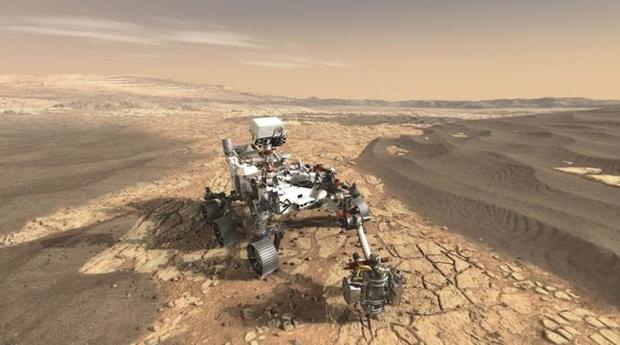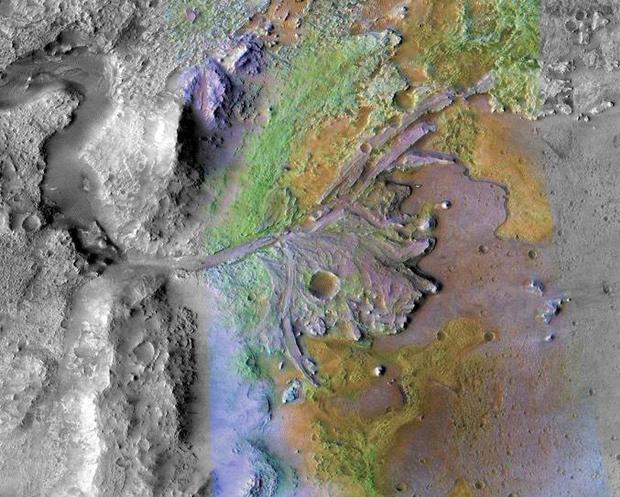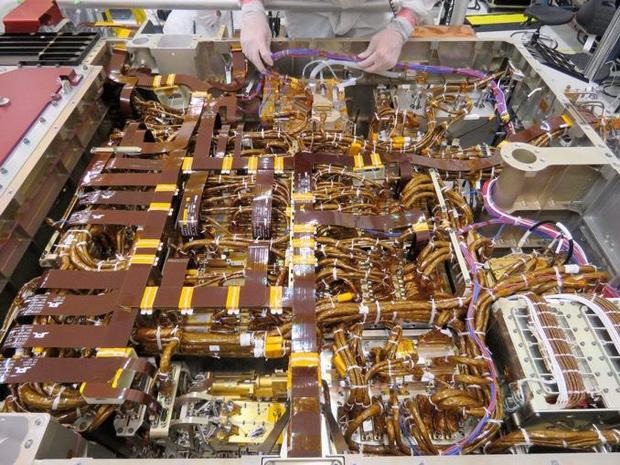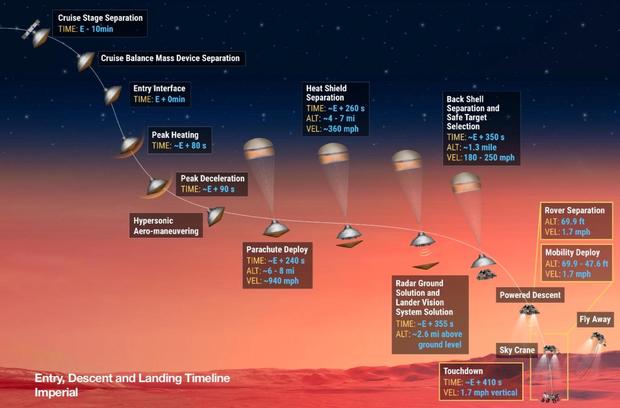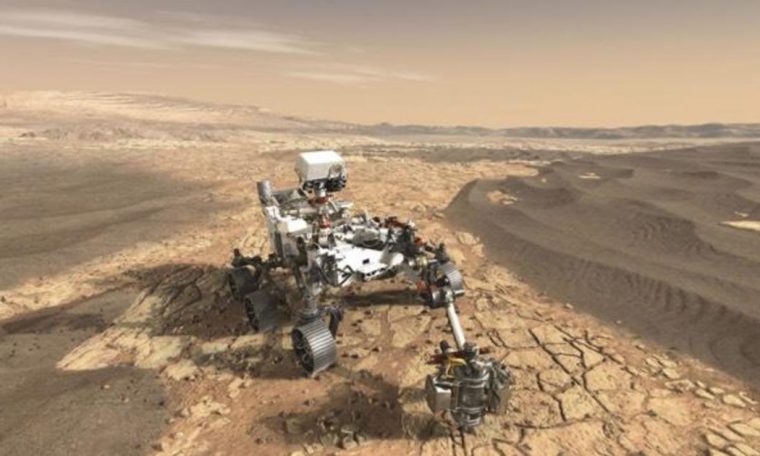
After contending with technical challenges and then the coronavirus pandemic, NASA is finally ready to launch its $2.4 billion nuclear-powered Perseverance Mars rover Thursday morning. The high-stakes mission will look for signs of past microbial life and to collect rock and soil samples for eventual return to Earth.
The rover also will carry a small $80 million experimental helicopter that will attempt the first “Wright brothers’ moment” on Mars, and another experiment to test technology that one day could help astronauts by extracting oxygen from the mostly carbon dioxide atmosphere.
But finding and collecting scientifically valuable rock and soil samples, autonomously packaging them in slender, germ-free tubes and caching them on the surface for later retrieval is the primary goal of NASA’s eighth Mars lander, the most complex spacecraft ever built to explore the red planet.
NASA/JPL-Caltech
“It is definitely the most mechanically complicated thing that’s ever been in deep space,” said Adam Steltzner, chief engineer at the Jet Propulsion Laboratory, said of the sample collection mechanism. “The number of actuators and piece parts per unit volume is higher than anything we’ve ever done.”
And the reason for all that complexity?
“We’re trying to do something that would take probably a team of several geologists and a truck and some temporary laboratory equipment to be able to do,” he said. “We’re going to pull samples, rocks, intact samples, out of rocks, we’re going to hermetically seal those samples immediately into sterile, hyper-clean sample tubes … for eventual return to Earth.”
Built with the intricacy and precision of a Swiss watch, the rover’s sampling system “is the simplest that could be made to do all the things it has to do,” Steltzner said. “But it is the most complicated system we’ve ever produced.”
The Perseverance mission comes on the heels of two high-profile launches over the last week and a half by China and the United Arab Emirates to send their own probes to Mars, the first interplanetary missions launched by either nation.
Looking for signs of past life
But Perseverance is in a class by itself, built explicitly to help answer one of the most profound questions in humanity’s quest to understand the cosmos: Are we alone? Or did life gain a foothold, even briefly, on at least one other planet and, by extension, perhaps on planets beyond our solar systems?
While other bodies in the solar system might host habitable subsurface oceans and environments where living organisms might be present, “Mars really gives us the best opportunity in the short term to make a significant discovery that will forever change how we think of ourselves and forever change how we think of space exploration in general,” said NASA Administrator Jim Bridenstine.
If evidence of past life is, in fact, found, “I think people are going to be so excited about the discovery and what comes next that that we’re going to be doing missions throughout the solar system.”
NASA/JPL-Caltech/MSSS/JHU-APL
Targeting the layered remnants of an ancient river delta on the floor of a 28-mile-wide crater that once harbored a body of water the size of Lake Tahoe, Perseverance will use a battery of high-tech cameras and other instruments to search for the “biosignatures” of primitive life that might have flourished on the red planet in the distant past.
NASA and the European Space Agency plan to bring samples from that ancient, no doubt habitable, environment back to Earth around the end of the decade for detailed laboratory analysis.
“Perseverance is going to drill and prepare samples for return and cache them on the surface of Mars,” said Lori Glaze, director of planetary science at NASA Headquarters. “In 2026, a fetch rover will be launched to collect those samples and bring them to a rocket that will launch them into orbit around Mars. Another orbiter will rendezvous and capture those samples for safe delivery to Earth.
“If it sounds complicated, it is,” she said. “But NASA’s investments in developing autonomous robots and landing large payloads on Mars have laid the groundwork for a successful sample return campaign.”
Launching on a seven-month journey
Perseverance, named by a Virginia seventh grader in a NASA contest, is scheduled for liftoff from Cape Canaveral atop a United Launch Alliance Atlas 5 rocket at 7:50 a.m. EDT Thursday. The flight will come midway through a planetary launch window that only opens once every 26 months when Earth and Mars are in favorable positions.
The United Arab Emirates took advantage of this year’s window on July 19 when a Japanese H-2A rocket boosted the UAE’s Hope orbiter into space and onto a trajectory to Mars. Built in cooperation with three U.S. universities, Hope is designed to study the red planet’s atmosphere to learn more about the mechanisms responsible for its slow-but-steady thinning.
Four days after Hope’s launch, China sent off its first Mars mission — Tianwen-1 — using a powerful Long March 5 rocket, a much more ambitious orbiter-rover combination that, if successful, will demonstrate the growing maturity of the Chinese space program.
NASA’s Perseverance team, struggling to complete processing and pre-launch tests amid coronavirus work restrictions, originally planned to launch the rover on July 17, but the flight was delayed by ground processing issues that used up half of the available launch window.
NASA/JPL-Caltech
The rover, encapsulated in a large payload fairing, was finally mounted atop the Atlas 5’s Centaur second stage on July 7. Its nuclear power pack was installed on July 20 and on Tuesday, the rocket and its payload were hauled to launch complex 41 for final preparations.
“Atlas is go, Centaur is go, and we are literally chomping at the bit to take this nuclear powered dune buggy out to Mars,” said Tory Bruno, president and CEO of United Launch Alliance.
Equipped with four strap-on solid-propellant boosters for extra power, the Atlas 5 will generate 2.3 million pounds of thrust at the moment of liftoff and accelerate Perseverance and its interplanetary cruise stage to a velocity of nearly 26,000 mph, fast enough to escape Earth’s gravitational clutches.
“This rocket is going to leap off the pad with this relatively tiny payload, so do not blink when they say ‘ignition,'” Bruno quipped.
Hope, Tianwen-1 and Perseverance will all follow looping 300-million-mile-long trajectories aimed at points in space where Mars will be in seven months. Hope and Tianwen-1 are expected to brake into orbit around Mars next February. The Chinese rover will remain attached to the orbiter for several months before being released for descent to touchdown on a broad plain known as Utopia Planitia.
“Seven minutes of terror” before landing
Perseverance will reach Mars on February 18, plunging straight into the atmosphere for white-knuckle descent to Jezero Crater near the river delta and lake bottom scientists are so eager to explore.
Resembling NASA’s still-operational Curiosity rover, which landed in Gale Crater in 2012 and confirmed the past habitability of Mars, Perseverance will use the same entry, descent and landing (EDL) technique famously described as “seven minutes of terror.”
Slamming into the atmosphere at some 12,100 mph, Perseverance’s heat shield will endure temperatures as high as 2,370 degrees as atmospheric friction slows the craft to just under 1,000 mph in four minutes. At that point, at an altitude of about seven miles and a velocity of around 940 mph, a 70.5-foot-wide parachute will unfurl.
NASA/JPL-Caltech
The heat shield will fall away 20 seconds later, exposing Perseverance to the elements. Shortly after, its radar system and cameras will begin actively measuring altitude and velocity while mapping the surface below and comparing the view to orbital maps stored in on-board memory.
The “terrain relative navigation” system, being used for the first time, will enable Perseverance to select the best possible landing site in the targeted footprint, moving the touchdown point by up to 2,000 feet as required to avoid large boulders or steep slopes that might otherwise cause problems.
Five minutes and 50 seconds after atmospheric entry, at an altitude of about 1.3 miles, Perseverance will be released from its backshell and parachute, falling freely at a velocity of about 190 mph. Seconds later, the rover’s sky crane jet pack will fire up to begin the rocket-powered descent phase of the landing.
By the time it reaches an altitude of just 66 feet, the sky crane will be descending at a sedate 1.7 mph. It will gently lower Perseverance to the surface on a tether, cutting the cable when the flight computer detects “weight on wheels” about six minutes and 50 seconds after entry. The no-longer-needed sky crane then will fly away, crashing to the surface a safe distance away.
Because of the 117-million-mile distance between Earth and Mars on landing day, radio signals confirming a successful touchdown — or their absence, indicating problems or even outright failure — will not be noted at the Jet Propulsion Laboratory until about 11 minutes after the fact.
Steltzner helped orchestrate the first sky crane landing with Curiosity. Even though terrain relative navigation and other upgrades mean better odds of a successful touchdown the second time around, “in some ways, it’s riskier,” he said, “because if we screw it up this time, we have no excuse. Right? We missed something.”
“But I think our odds are better,” he added. “We’ve taken the intervening eight years and the team has been working almost that entire time to drive risk down. So I think we’re in a better spot than we were on on Curiosity.”
NASA/JPL-Caltech
NASA’s newest rover
Perseverance tips the scales at 2,260 pounds, is roughly 10 feet long, nine feet wide and seven feet tall. It is equipped with a multi-joint robot arm, stretching seven feet when fully extended, that carries a rotating 99-pound turret at its far end housing a camera, a rock drill and chemical analyzers.
The rover’s body is mounted on six ribbed wheels arranged in a “rocker-bogie” design that evenly distributes the weight and allows it to easily roll over low-lying rocks.
Power is provided by a multi-mission radioisotope thermoelectric generator, or MMRTG, that produces heat from the decay of 10.6 pounds of radioactive plutonium 238 dioxide. That heat produces 110 watts of power to operate Perseverance and charge two lithium-ion batteries to meet higher demands during science operations.
Excess heat from the MMRTG also is used to keeps the rover’s sensitive electronics warm in sub-freezing temperatures.
Perseverance is equipped with 23 cameras, 13 computers and seven science instruments:
- Mastcam-Z: Two zoomable cameras on the rover’s remote sensing mast capable of high-definition video and color stereo/3D panoramas
- MEDA (Mars Environmental Dynamics Analyzer): A suite of weather and meteorology sensors
- MOXIE (Mars Oxygen ISRU Experiment): A technology demonstration to find out whether oxygen can be extracted from the martian atmosphere; scaled-up versions could one day help astronauts produce their own air and rocket propellant
- PIXL (Planetary Instrument for X-ray Lithochemistry): Mounted on the rover’s robot arm, PIXL will fire X-ray beams at rocks to determine their elemental chemistry
- RIMFAX (Radar Imager for Mars’ Subsurface Experiment): A ground-penetrating radar to map sub-surface layering
- SHERLOC (Scanning Habitable Environments with Raman & Luminescence for Organics & Chemicals): An ultraviolet laser located near PIXL on the rover’s robot arm that is designed to look for organic molecules
- SuperCam: A camera-laser combination designed to study the chemistry of rocks and soil
Also on board: three silicon chips carrying the names of 10.9 million people from around the world who signed up to tag along in spirit.
NASA/JPL-Caltech
Flight controllers, scientists and engineers at JPL and remote work sites around the world will spend the rover’s first 90 days, or “sols,” on Mars testing the the lander’s science instruments, cameras and subsystems, updating flight software, unstowing its robot arm and carrying out short test drives.
“Once we’re on the surface, we really are only able to command the vehicle once a day,” said Matt Wallace, Perseverance deputy project manager. “And so it’ll sleep and conserve power overnight. It’ll wake up in the morning, we’ll send a sequence of commands, give it its daily set of activities to do and then it has to carry them out pretty much by itself.
“It has to make the decisions on how to drive to the target, and how to do a lot of that sampling work as well as keeping itself safe under adverse anomalous conditions. And so there’s a tremendous amount of autonomy in the vehicle. It’s one of the things that makes the system so complex.”
The Ingenuity helicopter
Before beginning its exploration of Jezero Crater and the search for biosignatures, Perseverance will be commanded to release the solar-powered Ingenuity helicopter, named by an Alabama high school student, from an attachment fixture on the rover’s belly.
The rover then will drive a safe distance away and aim its cameras at the helicopter while it carries out a series of up to five test flights, the longest lasting about 90 seconds. Maximum altitude will be about 15 feet during flights carrying Ingenuity up to 160 feet downrange.
The drone carries no science instruments. Its purpose is simply to demonstrate the feasibility of flight in the thin martian atmosphere. Two pairs of four-foot-long counter-rotating blades will spin at about 2,400 rpm to achieve liftoff.
NASA/JPL-Caltech
“This is really something that’s cutting edge, something that’s never been attempted before,” said Wallace. “The atmosphere of Mars is only 1 percent the density that we have here on the Earth, and trying to control a system like this under those conditions is not easy. … This is something that we’re taking with us so that we can learn how to do this for future missions.”
Searching for clues in the crater
With Ingenuity’s testing complete, Perseverance will finally be ready to begin its search for biosignatures across the now-rocky floor of Jezero Crater. Orbital photos show an inflow channel on one side where a river emptied into the crater three to four billion years ago, building up a well-preserved delta.
“One of the great things about Jezero Crater is this delta,” said Ken Farley, the rover project scientist. “A delta is where you get the deposition of very fine grained (material), basically a mud. So mud comes in, gets carried down the river, it hits the slack water of the Lake and the mud settles out.
“The beauty of this is that anything that is either carried down the river that might have been alive, or things that lived in the lake, will get buried in this very (favorable) environment. … So we know that we have a habitable environment with a high preservation potential.”
The oldest undisputed signs of life on Earth date back about 3 billion years in the form of stromatolites, clearly visible formations left behind by single-celled microbes.
Perseverance will study rocks from a similar environment and from a similar timeframe in martian history, a time when Mars was a warmer, wetter world that supported rivers, lakes and oceans, looking for patterns that might indicate a biological origin.
“So are there stromatolites on Mars? We don’t know,” said Tonja Bosak, a member of the Perseverance science team at MIT. “What are these carbonates on Mars? We don’t know.
“But we are very excited to start looking at them. We certainly have a great suite of instruments to do so. And we have many sets of trained eyes that will be ready to sample the best rocks possible to bring to Earth and start asking these questions about possibly early life on Mars.”
While Perseverance’s mission is perhaps the most technically challenging in the history of Mars exploration, getting the samples back to Earth represents an even greater hurdle involving multiple spacecraft from NASA and the European Space Agency.
Another rover will be required to fetch the samples and deliver them to a lander for stowage aboard a solid-propellant rocket. Once blasted into Mars orbit, another spacecraft will have to rendezvous, collect the sample container and then make the long trip back to the inner solar system.
“If we are ever to send humans to Mars, there are a lot of things that need to be learned, and one of them is we have to learn how to launch something off the surface of Mars and bring it back to Earth,” Farley said.
And do it safely, keeping the samples isolated and free of contamination by from any organisms that might hitch a ride to Mars aboard Perseverance and then during atmospheric entry, landing and transport to waiting scientists.
“We are in a unenviable state of looking for life, either microbes or organic molecules, from a place, Mars, that almost certainly does not have (it today),” Farley said. “If it has any, it will have very little. And we are trying to launch a spacecraft from a planet which is absolutely dripping with both.
“So we have to get everything clean,” he said. “We are the worst place in the solar system to launch a spacecraft to look for low levels of life and organics. So it’s a special challenge.”

